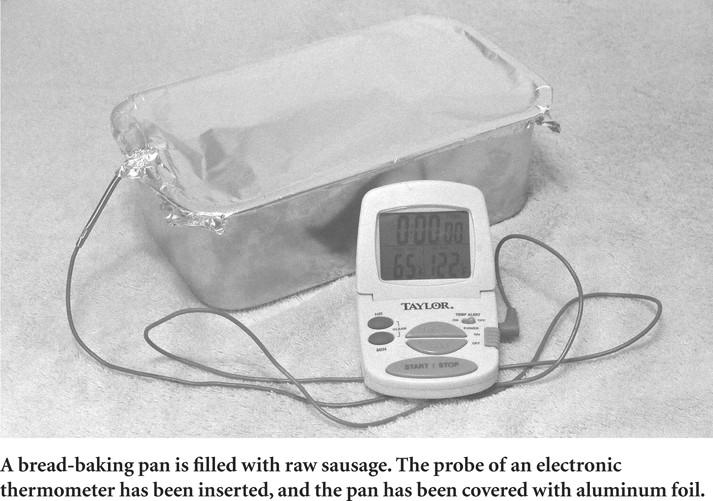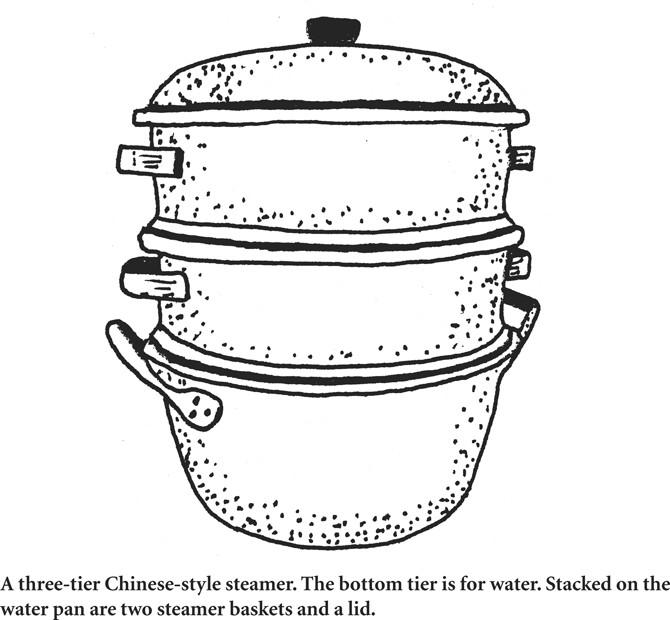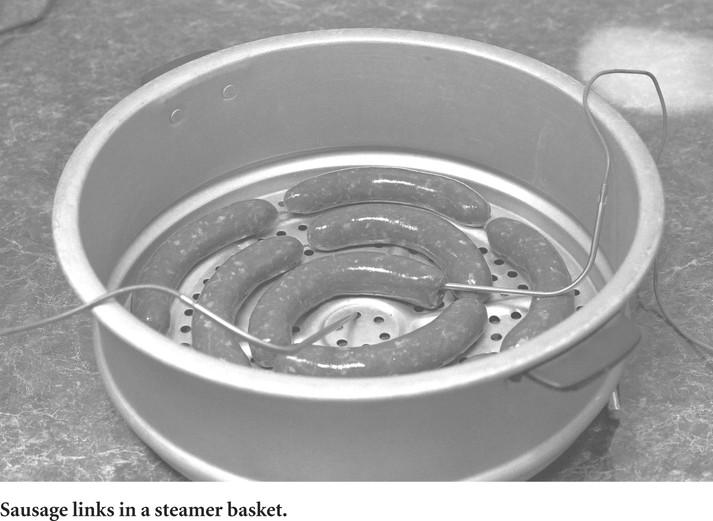Mastering the Craft of Making Sausage (15 page)
Read Mastering the Craft of Making Sausage Online
Authors: Warren R. Anderson
Tags: #Methods, #Cooking, #General, #Specific Ingredients, #Cooking (Sausages), #Sausages, #Meat

SAUSAGE LOAF (LUNCHMEAT LOAF)
Sausage need not be made into patties or stuffed into casings—a common bread-baking pan can be used to mold and cook the sausage. The finished product will be a loaf that can be sliced into delicious and economical luncheon meat. The following instructions can be used to process and cook many varieties of sausage in a bread-baking pan:

1. Follow the instructions in the recipe for grinding the meat and blending the seasoning. Knead the mixture of ground meat and seasoning for about three minutes, or until it is uniform.
2. Rub the inside of a loaf pan with butter, margarine, or shortening, and pack the sausage paste into the pan. (Some sausage varieties are emulsified before the paste is packed in the loaf pan.) Cover the loaf pan tightly with aluminum foil or plastic food wrap—foil is preferred. (If available, use a loaf pan made of non-reactive material such as Pyrex, ceramic, Teflon coated metal, or stainless steel. If a non-reactive pan is not available, you might wish to line the loaf pan with plastic food wrap rather than rubbing the inside with grease. My loaf pan measures about 8¾ × 5 × 3 inches. In metric measurements: 22 × 13 × 8 cm.)
3. Refrigerate the sausage overnight to allow flavors to blend.
4. Lift the aluminum foil cover, insert the cable probe of an electronic thermometer into the center of the loaf, and reseal the aluminum foil. Steam the loaf at between 170° F (77° C) and 180° F (82° C) until the internal temperature is 160° F (71° C)—or 165° F (74° C) if the sausage contains poultry or wildfowl. (For steaming instructions, please see the section
Steaming Sausage
that appears later in this chapter.)
5. Remove the loaf from the bread-baking pan, let it cool in front of an electric fan for about one hour, and refrigerate it. The loaf should remain un-covered—or covered only with paper towels—while it is being chilled. The next morning the loaf may be sliced and wrapped with plastic wrap. Double wrap and freeze the portion that will not be consumed within a few days.
SAUTÉING SAUSAGE LINKS
Sausage links stuffed in either natural casings or collagen casings are excellent sautéed. Because sautéing causes the surface to brown, an extra level of flavor is added to the sausage. This is especially desirable for fresh sausage links, but cured—or cured and smoked links—also benefit from the extra flavor.
For maximum retention of the juices, always cook the sausages over medium-low heat. A little oil should be added to a frying pan that has been heated to the cooking temperature. A preheated pan with preheated oil will help prevent the sausages from sticking. Slowly brown one side of the links, turn them over and cover. Turn the links occasionally so that they will brown evenly. The cover over the links helps to retain the heat and creates a high humidity environment. The result is that the links cook faster and more uniformly, and the high humidity steams the links and helps to tenderize the casings. A few tablespoons of water or wine will help to insure high humidity.
When the sausages appear to be approaching the target temperature, the internal temperature should be checked with an instant-read thermometer. Insert the stem about 2½ inches (6.5 cm) into a sausage, and wait about 10 seconds until the needle becomes stable. At this point, you will need to decide whether to cover the links to get the internal temperature going up faster, or uncover and try to improve the browning.
The links are done when the internal temperature is between 155° F (68° C) and 160° F (71° C). Depending on the thickness of the links, afterheat should carry the temperature to 160° F (71° C). If the sausage contains poultry or wildfowl, the target temperature is 165° F (74° C), so you need to remove the sausages from the sauté pan when the internal temperature is between 160° F (71° C) and 165° F (74° C).
Another method of sautéing sausages is to precook them first by poaching or steaming. Since the sausages are fully cooked, they need only be heated and browned.
POACHING SAUSAGE
If stuffed sausage is cooked in hot water at a temperature well below the boiling point (or in other hot liquids such as broth, beer, or wine), it is called
poaching
.
Simmering
also means cooking below the boiling point, but simmering implies a slightly higher temperature than that used for poaching. Poaching is a gentle and efficient way to cook sausage. It is gentle because the cooking temperature is just a little above the target temperature. It is efficient because water is a good conductor of heat. The water temperature is easy to control and provides uniform and gentle cooking with little effort.
The disadvantages are that poaching in plain water does not add flavor or color. In fact, there will be some loss of flavor due to some salt and other seasonings being dissolved by the liquid. Poaching is often used to cook smoked sausage and large lunchmeat-type sausages. It is also used to reheat sausages that have already been cooked—emulsified sausages, for example. If poaching is used for fresh sausages, it is usually used for fresh sausages that will be fried, grilled, or broiled later.
To minimize loss of flavor when poaching sausage stuffed in fibrous casing, each chub of sausage should be wrapped in at least two layers of plastic food wrap, and the food wrap should be twisted and sealed at both ends with wire bread-ties. This will provide water resistant properties comparable to that of a plastic casing.
Poaching is easy. Heat the water, or other liquid, to 180° F (82° C). A stock-pot is an ideal vessel for cooking a large quantity. There should be enough liquid to cover the sausages completely. If water is being used, add ½ teaspoon of salt for each quart (liter). When the sausages are placed in the water, they will lower the temperature. Bring the temperature back up to 175° F (79° C). While the sausages are cooking, try to maintain the liquid temperature between 170° F
(77°
C) and 180° F (82° C). It is best to use something like a round straining basket to hold the sausages under the water. Stir the sausages from time to time to ensure uniform exposure to the hot water.

The links, or fibrous casing chubs, are done when the internal temperature is between 155° F (68° C) and 160° F (71° C). Depending on the thickness of the sausage, afterheat should carry the temperature to 160° F (71° C). If the sausage contains poultry or wildfowl, the target temperature is 165° F (74° C), so you need to remove the sausages from the hot water when the internal temperature is between 160° F (71° C) and 165° F (74° C).
If sausages stuffed in natural casings will not be eaten soon, immerse them in ice water until the internal temperature is 110° F (43° C). Refrigerate immediately.
Sausage stuffed in fibrous casing should be air-cooled at room temperature for about one hour. The use of an electric fan will help cool the chubs. After one hour of cooling at room temperature, refrigerate the chubs, uncovered. Cooling these sausages in ice water might cause a loss of flavor when the sausage cools and shrinks. This shrinkage can cause cold water to be sucked into the fibrous casing, and the water will dilute the flavor.
The cooking and chilling of sausage packed in fibrous casings can cause the casing to wrinkle. This wrinkling is harmless, but many of the wrinkles will disappear if the chilled chub is dipped into boiling water for a short time.
Control of both cooking temperature and internal temperature is most easily accomplished by using two thermometers—one inserted in a sausage, and the other in the hot liquid. Electronic thermometers with a cable probe or instant-read dial thermometers work well for these tasks.
STEAMING SAUSAGE
When professional cooks steam food, they usually turn the heat high enough to produce a rolling boil, and they cover the steamer with a tight-fitting lid. Under these conditions, the temperature of the steam will be essentially the same as that of the boiling water. Cooking sausage in such a hot environment is unnecessarily harsh; low-temperature steaming is perfect for sausage. For many years, I used this low temperature steaming technique for cooking Chinese-style marinated-and-steamed fish, and later I discovered that it is also very good for steaming sausage. In fact, I rarely poach sausage nowadays; I steam it.

Low-temperature steaming, I believe, produces better results than poaching. When sausages are poached, they are immersed in hot water. The hot water seems to extract more favor from the sausages than does steam. Also, when sausages are steamed, the use of plastic food wrap gives even more protection against loss of flavor; they are bathed in their own juices while being cooked. Wrapping sausage links stuffed in natural casing may be a little troublesome— and probably unnecessary—but it is no trouble at all to wrap the larger fibrous casings with plastic food wrap.
A Chinese-style aluminum steamer works very well. The 12-inch (30 cm) diameter size is adequate for home use, and it can be purchased by mail order, or at most Asian grocery stores, for about $45. A stockpot with improvised steaming racks inside works equally well. When a steamer is used, it is best to have two electronic thermometers with cable probes—one probe continuously measures the internal temperature of the sausage, while the other probe continuously measures the temperature inside the steamer.


